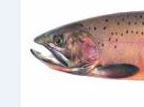Restoring Native Fish
Fish biologists successfully restored native Westslope Cutthroat Trout to 21 lakes in Northwestern Montana.
- October 11, 2017
- John Harrison

Using equipment ranging from horses to helicopters, fish biologists successfully rebuilt native Westslope Cutthroat Trout populations over the last 10 years in 21 lakes in the drainage of the South Fork Flathead River in northwestern Montana, where cutthroats had interbred with introduced rainbow trout and created undesirable hybrid populations.
The South Fork watershed, which was isolated from the rest of the Flathead system by the construction of Hungry Horse Dam in the 1950s, includes more than half of the remaining interconnected populations of genetically pure westslope cutthroat trout, a species that has declined to less than 10 percent of its historic range in the United States as the result of habitat degradation, hybridization, and competition with introduced fish. The same is true in the South Fork basin, where the historic stocking of headwaters lakes, competition with other species including nonnative Rainbow Trout and Yellowstone Cutthroat Trout led to the spread of hybridization and the gradual loss of locally adapted gene pools of native Westslope Cutthroat.

Habitat problems include erosion, stranded culverts that once passed fish, and cow-trampled stream beds.
The legacy of native trout and the fisheries they support is important to the state, and so 10 years ago biologists with Montana Fish, Wildlife and Parks and the National Forest Service launched a conservation strategy to remove the sources of nonnative trout from 21 headwater lakes where hybridization occurs and then reestablish native westslope cutthroat trout populations.
“Without a doubt the principle concern is hybridization with rainbow trout,” Matt Boyer of Montana Fish, Wildlife and Parks told the Power Council in a presentation at a meeting this month in Columbia Falls, Montana.
There were many issues to account for, including the proposed Endangered Species Act listing of Westslope Cutthroat, effects of Rotenone on nontarget species, and the potential for economic impacts to recreational fishing guides and outfitters.
Biologists used a fish poison to prepare the lakes for restocking with cutthroat, sometimes traveling 10-25 miles on horseback to sample fish and restock lakes as some were inside the Bob Marshall Wilderness. Helicopters helped biologists reach remote lakes in non-wilderness areas.
Fish were collected from four local donor streams, reared in a hatchery, and spawned to produce fry to plant in the treated lakes. The first two lakes were treated in 2007, and the last of the 21 was treated this year, bringing the project to a successful conclusion, Boyer said. In six lakes a technique called “genetic swamping” proved effective. This means introducing high numbers of the desired, native species in order to overwhelm the undesirable species. Fisheries in the lakes have rebounded and are flourishing and popular.
“We’re looking at applying this model of conservation elsewhere in the Flathead drainage,” Boyer said. “It’s also a good example of successes we can make elsewhere in the Columbia River Basin.”
The project is funded by the Bonneville Power Administration through the Hungry Horse Mitigation Habitat Restoration project in the Council’s Columbia River Basin Fish and Wildlife Program. The Program calls for preventing the introduction of non-native and invasive species in the Columbia River Basin and suppressing or eradicating non-native and invasive species.


